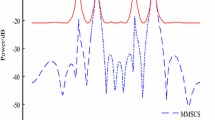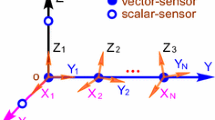Abstract
The existing SRV-MVDR (semi-real-valued MVDR) algorithm is only applicable to the pressure sensors array and cannot distinguish between mirror radiation sources and real source (DOA fuzzy), and this paper presents a method of vector sensors array SRV-MVDR based on subspace projection. Compared with the existing SRV-MVDR, only half spectrum search is needed to solve the DOA fuzzy problem. No subsequent discrimination is needed. The data collected by vector sensors array are processed jointly by using the idea of dimensionality reduction so that it satisfies the processing condition of SRV-MVDR method. Theoretical analysis and computer simulation show that this method has robustness. At the same time, it is more suitable for low SNR and small snapshots and has broad prospects in practical engineering.




Similar content being viewed by others
References
Schmidt R (1986) Multiple emitter location and signal parameter estimation. IEEE Trans Antennas Propag 34(3):276–280
Liu GH, Chen H, Sun XY et al (2016) Modified MUSIC algorithm for DOA estimation with nyström approximation. IEEE Sens J 16(12):4673–4674
Roy R, Paulraj A, Kailath T (1986) ESPRIT—a subspace rotation approach to estimation of parameters of cisoids in noise. IEEE Trans Acoust Speech Signal Process 34(5):1340–1342
Steinwandt Jens, Roemer Florian, Haardt Martin (2017) Generalized least squares for ESPRIT-type direction of arrival estimation. IEEE Signal Process Lett 24(11):1681–1685
Li Jianfeng, Jiang Defu, Zhang Xiaofei (2017) DOA estimation based on combined unitary ESPRIT for coprime MIMO radar. IEEE Commun Lett 21(1):96–99
Sørensen Mikael, De Lathauwer Lieven (2016) Multiple invariance ESPRIT for nonuniform linear arrays: a coupled canonical polyadic decomposition approach. IEEE Trans Signal Process 64(14):3693–3704
Wax M, Kailath T (1985) Detection of signals by information theoretic criteria. IEEE Trans Acoust Speech Signal Process 33(2):387–392
Wu HT, Yang J, Chen FK (1995) Source number estimation using transformed Gerschgorin radii. IEEE Trans Signal Process 43(6):1325–1333
Cao JW, Lai X P(2016). MVDR beamformer analysis of acoustic vector sensor with single directional interference. In: IEEE international symposium on circuits and systems (ISCAS), pp 774–777
Capon J (1969) High-resolution frequency wavenumber spectrum analysis. Proc IEEE 57(8):1408–1418
Yan Feng-Gang, Liu Shuai, Wang Jun et al (2018) Unitary direction of arrival estimation based on a second forward/backward averaging technique. IEEE Commun Lett 22(3):554–557
Wang B, Chen F, Chen Y et al (2017) Energy DOA estimation of MUSIC symmetrical compressed spectrum on vector sensors array. Clust Comput 2017(10):1–8
Cao XH, Liu HW, Wu SJ (2008) DOA estimation based on online music algorithm. J Electron Inf Technol 30(11):2658–2661
Huarng KC, Yeh CC (1991) A unitary transformation method for angle-of-arrival estimation. IEEE Trans Signal Process 39(4):975–977
Wu JX, Wang T, Suo ZY et al (2009) DOA estimation for ULA by spectral Capon rooting method. Electron Lett 45(1):84–85
Yan FG, Wang J, Shen Y et al (2015) Efficient direction-of-arrival estimation based on semi-real-valued Capon. J Electron Inf Technol 37(04):811–816
Zhang W, Shang L (2017) Method of direction of arrival tracking for multiple targets under water with single vector hydrophone. J Natl Univ Def Technol 39(02):114–119
Cao Jiuwen, Liu Jun, Wang Jianzhong et al (2017) Acoustic vector sensor: reviews and future perspectives. IET Signal Process 11(1):1–9
Yun Yu, Ling Qing, Jiang Xu (2015) Pressure and velocity cross-spectrum of normal modes in low-frequency acoustic vector field of shallow water and its application. J Syst Eng Electron 26(2):241–249
Zhang L, Yao X, Yang D (2013) Feature extraction based on vector hydrophone in the waveguide environment. In: 2013 OCEANS-San Diego, pp 1–8
Tam Ping Kwan, Wong Kainam Thomas, Song Yang (2014) An hybrid Cramér-Rao bound in closed form for direction-of-arrival estimation by an “acoustic vector sensor” with gain-phase uncertainties. IEEE Trans Signal Process 62(10):2504–2516
Golub GH, Van Loan CH (1996) Matrix computations. The Johns Hopkins University Press, Baltimore, MD, pp 70–74
Acknowledgements
This work was supported by National Natural Science Foundation (11574120, U1636117); the Natural Science Foundation of Jiangsu Province of China (BK20161359); Postgraduate Research & Practice Innovation Program of Jiangsu Province (SJCX17_0604); The Open Project Program of the Key Laboratory of Underwater Acoustic Signal Processing, Ministry of Education, China (UASP1503); The Science and Technology on Underwater Acoustic Antagonizing Laboratory, Systems Engineering Research Institute of CSSC(Grant No. MB80038) and Six Talent Peaks project of Jiangsu Province.
Author information
Authors and Affiliations
Corresponding author
Rights and permissions
About this article
Cite this article
Wang, B., Chen, F. & Ge, H. Subspace projection semi-real-valued MVDR algorithm based on vector sensors array processing. Neural Comput & Applic 32, 173–181 (2020). https://doi.org/10.1007/s00521-018-3791-8
Received:
Accepted:
Published:
Issue Date:
DOI: https://doi.org/10.1007/s00521-018-3791-8




